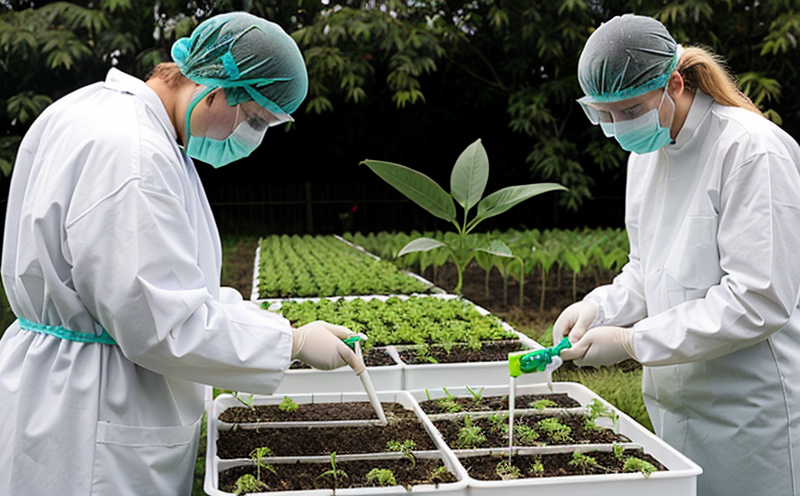Bacterial Culture Isolation Testing in Plants
Bacterial culture isolation testing is a crucial process within agriculture and forestry testing aimed at identifying specific bacterial pathogens that may cause diseases in plants. This method plays an essential role in ensuring the health of crops, trees, and other vegetation by detecting potential threats early on, which helps to prevent widespread infections and crop losses.The primary goal of this test is to isolate bacteria from plant samples for further analysis using various microbiological techniques. The process involves collecting samples such as leaves, roots, or soil from suspected sites where bacterial diseases are prevalent. These samples are then processed in a laboratory setting under controlled conditions to prevent contamination and ensure accurate results.
Once the sample is prepared, it undergoes several steps including dilution, plating on selective media, incubation, and identification of colonies that exhibit characteristic morphological traits indicative of bacterial pathogens. Advanced molecular methods like polymerase chain reaction (PCR) or sequencing can also be employed to confirm the presence of specific bacteria.
This testing methodology ensures precision in diagnosing plant diseases caused by bacteria such as Erwinia carotovora, Pseudomonas solanacearum, Xanthomonas campestris, among others. Accurate identification enables growers and researchers to implement targeted management strategies tailored to each pathogen's lifecycle and spread dynamics.
| Pathogen | Disease Caused | Optimal Environmental Conditions | Treatment Strategies |
|---|---|---|---|
| Erwinia carotovora | Soft rot disease in cruciferous vegetables | Ambient temperature, high humidity | Chemical control with antibiotics; cultural practices like crop rotation |
| Pseudomonas solanacearum | Bacterial wilt in tomato and potato plants | Tropical to subtropical temperatures, moist environments | Use of resistant varieties; biological control agents |
| Xanthomonas campestris | Brown spot disease in cruciferous crops | Warm, humid conditions favoring high bacterial population growth | Sanitation measures; application of bactericides at early stages |
In conclusion, bacterial culture isolation testing is vital for maintaining plant health by providing valuable insights into the nature and extent of bacterial infections. This knowledge allows agricultural professionals to take proactive measures against these diseases effectively.
Customer Impact and Satisfaction
Implementing bacterial culture isolation testing has significant positive impacts on customers across various sectors, particularly in agriculture and forestry. By providing accurate diagnoses of plant diseases caused by bacteria, this service helps ensure sustainable crop production while minimizing economic losses due to disease outbreaks.For quality managers responsible for ensuring product safety and efficacy, having reliable data from bacterial culture isolation tests ensures they can make informed decisions regarding their supply chains and inventory management. Compliance officers benefit greatly from such services because accurate identification of pathogens supports adherence to regulatory standards set by international bodies like ISO or local governments.
R&D engineers find value in these tests as they contribute valuable information towards developing new varieties of plants resistant to bacterial diseases, improving existing cultivars' resilience, and formulating more effective pest management tactics. Procurement personnel involved in sourcing raw materials also appreciate this service since it guarantees the integrity and quality of purchased inputs.
Ultimately, satisfied customers report improved productivity levels, reduced incidence rates of crop failures, enhanced profitability through higher yields, and better resource utilization across all phases of plant cultivation processes.
International Acceptance and Recognition
- ISO/IEC 17025: This international standard outlines requirements for competence in testing and calibration laboratories, ensuring that facilities performing bacterial culture isolation testing meet stringent quality criteria.
- EN ISO 14698-1: Compliance with this European normative document demonstrates adherence to cleanroom classification standards necessary for maintaining sterility during sample preparation and culture growth stages.
- ASTM E2553: This American standard specifies guidelines for the use of real-time PCR technology in identifying microorganisms, which is often integrated into comprehensive bacterial culture isolation protocols.
- IEC 60601-2-27: Although primarily focused on medical devices, compliance with this international standard indicates robust quality assurance practices that extend to other fields requiring high precision microbiological analysis.
Bacterial culture isolation testing is universally accepted across numerous countries worldwide due to its critical role in protecting plant health and supporting sustainable agricultural practices. Laboratories accredited according to these standards are recognized for delivering consistent, reliable results that comply with global norms, thereby enhancing confidence among stakeholders involved in crop production.
Use Cases and Application Examples
Bacterial culture isolation testing finds application in diverse scenarios within the agriculture and forestry sectors. Here are some illustrative use cases:- Disease Outbreak Investigation: After identifying a bacterial disease outbreak affecting commercial crops, agricultural experts can conduct bacterial culture isolation tests to pinpoint the exact pathogen responsible.
- Crop Breeding Programs: Researchers involved in breeding programs aimed at creating new plant varieties focus on selecting parents known for their resistance to common bacterial pathogens. Genetic markers linked to such resistances are identified via bacterial culture isolation testing.
- Pest Management Strategies: In integrated pest management (IPM) approaches, understanding the bacterial flora present in soil or plant tissues guides decisions about appropriate fungicides and biological controls.
- Diagnostics for Nursery Operations: Seedling nurseries regularly perform these tests to ensure that none of their plants carry harmful bacteria before they are sold to end users.
In summary, bacterial culture isolation testing serves multiple purposes ranging from outbreak response measures to strategic research initiatives aimed at enhancing plant health and productivity. Its versatility makes it indispensable for maintaining robust agricultural systems globally.





